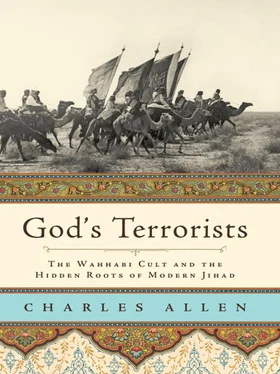Thus the adolescent Syed Ahmad became a student of probably the most radical and reactionary school in India at a time when the umma , the world community of Islam, felt itself threatened to a degree not experienced since the days of the Great Khans. The Ottoman sultanate, after centuries as the pre-eminent power in Eastern Europe and Western Asia, was suffering one reverse after another at the hands of the Austrians, Russians and French, while at the same time its authority was being undermined from within by a series of revolts by regional viceroys. In India it was the same story. As Mughal power at the centre waned, local Muslim governors were breaking away to set up their own regional principalities. These, in their turn, were being taken over one after another by the British East India Company, beginning in Bengal and the Carnatic and then pushing into the interior: in 1799 Tipu Sultan was defeated and killed at Seringapatam; in 1803 the Mughal emperor Badshah Shah Alam, great-great-grandson of Emperor Aurangzeb, suffered the last in a series of humiliations at the hands of foreign invaders when he signed over what little authority remained to him to become a pensioner of the British in Delhi.
Unable to match the growing military and economic power of Europe, Islam responded through religious revival in a variety of forms. Disgusted at his emperor’s craven response to the takeover of his city by the British, Syed Ahmad’s teacher Shah Abdul Aziz issued a fatwa that Delhi had been enslaved. ‘In this city the Imam ul-Muslimin [religious leader of the Muslims; thus, the Mughal Emperor] wields no authority,’ he declared. ‘The real power rests with the British officers. There is no check on them, and the promulgation of the commands of kufr [heathenism] means that in administration and justice, in matters of law and order, in the domain of trade, finance and collection of revenues – everywhere the kuffar [heathen infidels] are in power.’ He therefore declared Hindustan to be a domain of enmity ( dar ul-harb ), and that henceforward it was incumbent on all Muslims to strive to restore India to that blessed state which had prevailed in earlier times.
This fatwa was little more than a symbolic act of defiance, but there can be no doubt that young Syed Ahmad left the Madrassah-i-Rahimiya thoroughly radicalised and with the conviction that un-Islamic forces were threatening his faith. As an expression of this radicalisation he abandoned the name ‘Muhammad’ as blasphemous, and became Syed Ahmad.
Biographies of Syed Ahmad such as that already quoted from state that after eight years of study in Delhi he married and moved back to his home town of Rae Bareli as a mullah. But there are other versions, including a biography written by a nephew, which give widely differing accounts and dates – suggesting that the writers were following very different agendas. They demonstrate that Syed Ahmad gathered under the umbrella of his leadership a number of factions that were only willing to sink their religious differences while he remained alive. One has to pick one’s path through these competing histories with caution, but it seems highly probable that Syed Ahmad abandoned his studies in Delhi in his late teens to join his elder brother, an irregular horseman in the forces of a Pathan freebooter named AMIR KHAN.
Even the most hagiographical accounts accept that Syed Ahmad did indeed spend time with Amir Khan, although the claim is that he did so as pesh-imam or chaplain to the troops, during which time he exercised moral influence over Amir Khan’s band of Pathan soldiery, besides performing several miracles. What is glossed over is that Amir Khan was no jihadi fighting for Islamic values but a deeply unpleasant mercenary, a Yusufzai originally from the mountains of Buner who fought for whoever paid the most or offered the best prospect of booty. At this period Amir Khan commanded the cavalry of the half-mad Maratha warlord Jaswant Rao Holkar; in effect, he was helping a Hindu to plunder central India. In British eyes Amir Khan and his Pathans were nothing less than pindaris or marauders, notorious for their acts of cruelty and rapine. Colonel James Tod, who witnessed Amir Khan’s depredations at first hand, describes him in his Annals of Rajasthan as ‘one of the most notorious villains India has ever produced’. Nevertheless, as a means of bringing order to central India the British authorities in Bengal entered into negotiations with Amir Khan, and in 1817 recognised him as the ruler of a new principality named Tonk.
This alliance with the British was seen as a betrayal by Syed Ahmad, who quit Amir Khan’s service to return to the Madrassah-i-Rahimiya in Delhi, where he became one of several radical teachers, all disciples of Shah Abdul Aziz in the school of Shah Waliullah. Very soon, however, Syed Ahmad was marking out his own territory, making a name for himself through the intensity of his preaching and the forcefulness of his personality. Leaving his now elderly master, he took up residence in Delhi’s Akbar-abadi mosque beside the city’s famous Red Fort, to which crowds flocked to hear him preach and deliver religious judgements. Among the many who came to hear him was a man seven years his senior named SHAH MUHAMMAD ISMAIL, a nephew of Shah Abdul Aziz. After hearing Syed Ahmad preach one evening, Shah Muhammad Ismail was invited to join him in his room, where the two of them spent the night in a state of silent rapture contemplating God. Shah Muhammad Ismail then took the oath of religious allegiance known as baiat to become Syed Ahmad’s first disciple. He was soon joined by SHAH ABDUL HAI, a son-in-law of Shah Abdul Aziz, as Syed Ahmad’s second disciple. It is said that these two were Syed Ahmad’s ‘lovers’, although the word should probably be seen in the Sufi context of intense ecstatic devotion to one’s spiritual master. In the case of Shah Muhammad Ismail, this devotion extended to ghosting at least some of Syed Ahmad’s published writings and to writing the first biography. Indeed, there is a good case for concluding that the disciple had a major hand in smoothing out and filling in his master’s thinking: that Syed Ahmad was a man of action who spoke from the heart rather than the head, leaving his disciples to sort out the theological details.
From 1818 onwards Syed Ahmad’s name and his message of Islamic reform and revival began to be heard in Sunni mosques and meeting-places right across northern India, greatly assisted by the efforts of his more learned disciples. As he toured through the plains country north and west of the Jumna River, hundreds pledged themselves to his work by taking the oath of baiat. Yet it seems that Syed Ahmad was still at this time seeking to come to terms with Sufism, since he is on record as having himself taken oaths of allegiance not only to the order of Naqshbandi Sufism followed by his mentors but also to three other Sufi schools. The outcome of this search seems to have been a rejection of many aspects of Sufism as idolatrous, and a hardening of attitude.
At some point on Syed Ahmad’s preaching tour he arrived at the great city of Lucknow, then in chaotic decline but still the most important seat of Muslim learning on the sub-continent outside Delhi. Here his sermons were heard by a talib from Patna named WILAYAT ALI, then aged about eighteen or nineteen, who was won over to his cause and duly took the oath of allegiance. That, at least, is the received account of the conversion to Syed Ahmad’s cause of the man who was to follow him as the most influential leader of his movement – but there is an alternative version, of which more latter.
In about 1819 Syed Ahmad’s first disciple Shah Muhammad Ismail set down his master’s theology in a work entitled Sirat-ul-Mustaqim (the Straight Path) . It laid great stress on the doctrine of the oneness of God ( tawhid ), and on the importance of struggling against all heretical practices associated with innovation ( bidat ). ‘The law of the Prophet is founded on two things,’ it declares:
Читать дальше












